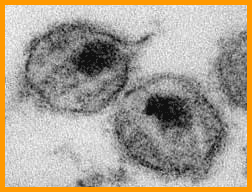HIV/AIDS (Acquired Immune Deficiency Syndrome) is believed to have originated in sub-Saharan Africa in the early twentieth century, and has since progressed to pandemic levels. The disease targets a victim's immune system, reducing the number of pathogen-fighting T-Cells in the blood, and making the victim more susceptible to otherwise treatable ailments. The effects of the virus are not only medical, however; more than 15 million have been orphaned by AIDS, and the economies of countries in which it is present have suffered greatly, resulting from the loss of many of their youngest and strongest citizens.

AIDS/HIV virus |
While an AIDS diagnosis is no longer a death sentence, as it once was, and methods of treatment such as antiretroviral drugs have become available, nevertheless the virus took an estimated 2.1 million lives in 2007, three quarters of which were in sub-Saharan Africa. About 40 million people currently suffer from HIV, of which 95% are in developing countries, and nearly 2/3 in sub-Saharan Africa. Despite common belief, the disease is not only transmitted via sexual intercourse, but also from mother to child during pregnancy, birth, or breastfeeding. Thus, generations of afflicted people may occur from one original victim, especially when treatment and decent living conditions are not available.
These stipulations make the disease both most common and most deadly in third-world countries. Partners in Health seeks to battle the world-wide spread of AIDS with programs that both battle the disease with antiretroviral drugs, and ensure a standard of living sufficient to suppress the virus from treatment onwards. This format for disease prevention and control is manifest in the PIH HIV Equity Initiative, a comprehensive treatment program that provides nutritional and social support alongside the disease-defeating drugs. The program's format has been imitated in various other disease-treatment regimes geared toward the poor; its four focuses are the fundamental building blocks of a cure for not only AIDS, but also other similar issues.
These four "pillars," as they are called, are responsible for not only treating the disease where it is present, but also for preventing and suppressing the disease's effects. The pillars seek to treat both AIDS and tuberculosis, which is a leading cause of death among AIDS patients, in tandem, to improve and increase the screening and treatment of AIDS, and to improve women's health, as a large number of AIDS-related deaths occur among women and their children. The structure of this program has proven immensely effective, particularly in Haiti, where it was first implemented through the Zanmi Lasante project; during the 2004 coup d'etat, no patients missed a single dose, proving the functional ability of the program, even during times of great chaos. However, despite the strides made by the HIV Equity program and others like it, no true progress can be achieved until HIV treatment is an endeavor undertaken by governments world-wide, fighting to reduce the insurmountable barrier of poverty and class division in order to make treatment universally available. PIH seeks to convert this dream into a reality- only with the power of international state support can the fight against HIV/AIDS be won once and for all.

